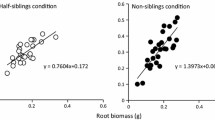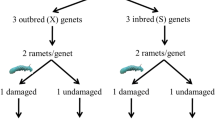Abstract
In this study, we investigated how neighbors (i.e., competitors) altered resistance phenotypes, namely plant size and levels of secondary compounds (iridoid glycosides), of individual plants and specifically tested whether neighbor identity mattered. We conducted a greenhouse experiment with Plantago lanceolata and Plantago major (Plantaginaceae) in which each species served as focal plants as well as neighbors in a factorial design. In addition, we harvested plants six and nine weeks after transplantation to test whether effects changed as plants grew. In both species, competition reduced plant size, and this effect increased over time. Plantago lanceolata neighbors suppressed growth of both focal plant species more than P. major neighbors. Effects of competition on levels of secondary compounds were more complex. Concentrations of iridoid glycosides were increased by competition in both species at harvest one. By the second harvest, an effect of competition on iridoid glycosides was found only in P. major. Neighbor identity influenced levels of iridoid glycosides in P. lanceolata at harvest one; concentrations were higher in plants grown with P. lanceolata neighbors than in plants grown with P. major neighbors. We also tested whether there was a trade-off between growth (biomass) and defense (levels of iridoid glycosides). Biomass and iridoid glycoside content were significantly correlated only in plants grown with competition and harvested at nine weeks, and this relationship was positive in both species, indicating that there was no trade-off between growth and defense. This study suggests that neighbor identity could play an important role in interspecific interactions, including the interactions of plants with other trophic levels.


Similar content being viewed by others
References
Adler LS, Schmitt J, Bowers MD (1995) Genetic variation in defensive chemistry in Plantago lanceolata (Plantaginaceae) and its effect on the specialist herbivore Junonia coenia (Nymphalidae). Oecologia 101:75–85
Agrawal AA (2000) Benefits and costs of induced plant defense for Lepidium virginicum (Brassicaceae). Ecology 81:1804–1813
Agrawal AA (2001) Phenotypic plasticity in the interactions and evolution of species. Science 294:321–326
Agrawal AA (2004) Resistance and susceptibility of milkweed: competition, root herbivory, and plant genetic variation. Ecology 85:2118–2133
Bazzaz FA, Chiariello NR, Coley PD, Pitelka LF (1987) Allocating resources to reproduction and defense. BioScience 37:58–67
Bergelson J, Purrington CB (1996) Surveying patterns in the cost of resistance in plants. Am Nat 148:536–558
Bowers MD (1991) Iridoid glycosides. In: Rosenthal GA, Berenbaum, MR (eds) Herbivores, their interactions with secondary plant metabolites, vol 1, 2nd edn. Academic, San Diego, CA, pp 297–326
Bowers MD, Collinge SK, Gamble SE, Schmitt J (1992) Effects of genotype, habitat, and seasonal variation on iridoid glycoside content of Plantago lanceolata (Plantaginaceae) and the implications for insect herbivores. Oecologia 91:201–207
Bowers MD, Stamp NE (1992) Chemical variation within and between individuals of Plantago lanceolata (Plantaginaceae). J Chem Ecol 18:985–995
Bowers MD, Stamp NE (1993) Effects of plant age, genotype, and herbivory on Plantago performance and chemistry. Ecology 74:1778–1791
Bryant JP, Chapin FS III, Klein DR (1983) Carbon/nutrient balance of boreal plants in relation to vertebrate herbivory. Oikos 40:357–368
Cipollini DF (2002) Does competition magnify the fitness costs of induced responses in Arabidopsis thaliana? A manipulative approach. Oecologia 131:514–520
Cipollini DF, Bergelson J (2001) Plant density and nutrient availability constrain constitutive and wound-induced expression of trypsin inhibitors in Brassica napus. J Chem Ecol 27:593–610
Coley PD, Bryant JP, Chapin FS III (1985) Resource availability and plant antiherbivore defense. Science 230:895–899
Darrow K, Bowers MD (1999) Effects of herbivore damage and nutrient level on induction of iridoid glycosides in Plantago lanceolata. J Chem Ecol 25:1427–1440
Fajer ED, Bowers MD, Bazzaz FA (1992) The effect of nutrients and enriched CO2 environments on production of carbon-based allelochemicals in Plantago: a test of the carbon/nutrient balance hypothesis. Am Nat 140:707–723
Feeny P (1976) Plant apparency and chemical defense. In: Wallace JW, Mansell RL (eds) Recent advances in phytochemistry, vol 10. Plenum, New York, pp 3–19
Fuchs A, Bowers MD (2004) Patterns of iridoid glycoside production and induction in Plantago lanceolata and the importance of plant age. J Chem Ecol 30:1723–1741
Gardner DR, Stermitz FR (1988) Hostplant utilization and iridoid glycoside sequestration by Euphydryas anicia individuals and populations. J Chem Ecol 14:2147–2168
Gershenzon J (1994) Metabolic costs of terpenoid accumulation in higher-plants. J Chem Ecol 20:1281–1328
Glynn C, Herms DA, Egawa M, Hansen R, Mattson WJ (2003) Effects of nutrient availability on biomass allocation as well as constitutive and rapid induced herbivore resistance in poplar. Oikos 101:385–397
Haeck J (1992) Phytosociology of Plantago habitats in The Netherlands and the relation with habitat characteristics. In: Kuiper PJC, Bos M (eds) Plantago: a multidisciplinary study. Springer, Berlin Heidelberg New York, pp 20–28
Hamilton JG, Zangerl AR, DeLucia EH, Berenbaum MR (2001) The carbon–nutrient balance hypothesis: its rise and fall. Ecol Lett 4:86–95
Harper JL (1977) Population biology of plants. Academic, New York
Harvey JA, Van Nouhuys S, Biere A (2005) Effects of quantitative variation in allelochemicals in Plantago lanceolata on development of a generalist and specialist herbivore and their endoparasitoids. J Chem Ecol 31:287–301
Hay ME (1986) Associational plant defenses and the maintenance of species diversity: turning competitors into accomplices. Am Nat 128:617–641
Herms DA, Mattson WJ (1992) The dilemma of plants: to grow or defend. Q Rev Biol 67:283–335
Höft M, Verpoorte R, Beck E (1996) Growth and alkaloid contents in leaves of Tabernaemontana pachysiphon Stapf (Apocynaceae) as influenced by light intensity, water and nutrient supply. Oecologia 107:160–169
Jarzomski CM, Stamp NE, Bowers MD (2000) Effects of plant phenology, nutrients and herbivory on growth and defensive chemistry of plantain, Plantago lanceolata. Oikos 88:371–379
Jones CG, Coleman JS (1991) Plant stress and insect herbivory: toward an integrated perspective. In: Mooney HA, Winner WE, Pell EJ (eds) Response of plants to multiple stresses. Academic, London, pp 249–282
Judd CM, McClelland GH (1989) Data analysis: a model-comparison approach. Harcourt Brace Jovanovich, Orlando, FL
Juenger T, Morton TC, Miller RE, Bergelson J (2005) Scarlet gilia resistance to insect herbivory: the effects of early season browsing, plant apparency, and phytochemistry on patterns of seed fly attack. Evol Ecol 19:79–101
Karban R (1993) Induced resistance and plant density of a native shrub, Gossypium thurberi, affects its herbivores. Ecology 74:1–8
Karban R, Baldwin IT, Baxter KJ, Laue G, Felton GW (2000) Communication between plants: induced resistance in wild tobacco plants following clipping of neighboring sagebrush. Oecologia 125:66–71
Koricheva J (1999) Interpreting phenotypic variation in plant allelochemistry: problems with the use of concentrations. Oecologia 119:467–473
Koricheva J (2002) Meta-analysis of sources of variation in fitness costs of plant antiherbivore defenses. Ecology 83:176–190
Lerdau M, Coley PD (2002) Benefits of the carbon–nutrient balance hypothesis. Oikos 98:534–536
Letourneau DK (1986) Associational resistance in squash monocultures and polycultures in tropical Mexico. Environ Entomol 15:285–292
Linhart YB (1988) Intrapopulation differentiation in annual plants. III. The contrasting effects of intra- and interspecific competition. Evolution 42:1047–1064
Linhart YB, Keefover-Ring K, Mooney KA, Breland B, Thompson JD (2005) A chemical polymorphism in a multitrophic setting: thyme monoterpene composition and food web structure. Am Nat 166:517–529
Marak HB, Biere A, Van Damme JMM (2000) Direct and correlated responses to selection on iridoid glycosides in Plantago lanceolata L. J Evol Bio 13:985–996
Marak HB, Biere A, Van Damme JMM (2002) Two herbivore-deterrent iridoid glycosides reduce the in-vitro growth of a specialist but not of a generalist pathogenic fungus of Plantago lanceolata L. Chemoecology 12:185–192
Marak HB, Biere A, Van Damme JMM (2003) Fitness costs of chemical defense in Plantago lanceolata L.: effects of nutrient and competition stress. Evolution 57:2519–2530
Miller TE (1995) Evolution of Brassica rapa L. (Cruciferae) populations in intra- and interspecific competition. Evolution 49:1125–1133
Newman JA, Bergelson J, Grafen A (1997) Blocking factors and hypothesis tests in ecology: is your statistics text wrong? Ecology 78:1312–1320
Pardo F, Perich F, Torres R, Delle Monach F (1998) Phytotoxic iridoid glycosides from the roots of Verbascum thapsus. J Chem Ecol 24:645–653
Peacor SD, Werner EE (2001) The contribution of trait-mediated indirect effects to the net effects of a predator. Proc Natl Acad Sci USA 98:3904–3908
Quinn GP, Keough MJ (2002) Experimental design and data analysis for biologists. Cambridge University Press, Cambridge
Rand TA (2003) Herbivore-mediated apparent competition between two salt marsh forbs. Ecology 84:1517–1526
Rhoades DF (1979) Evolution of plant chemical defense against herbivores. In: Rosenthal GA, Janzen DH (eds) Herbivores: their interactions with secondary plant metabolites, 1st edn. Academic, New York, pp 3–54
Richardson CJ, Ferrell GM, Vaithiyanathan P (1999) Nutrient effects on stand structure, resorption efficiency, and secondary compounds in everglades sawgrass. Ecology 80:2182–2192
Ridenour WM, Callaway RM (2001) The relative importance of allelopathy in interference: the effects of an invasive weed on a native bunchgrass. Oecologia 126:444–450
Rønsted N, Göbel E, Franzyk H, Jensen SR, Olsen CE (2000) Chemotaxonomy of Plantago. Iridoid glucosides and caffeoyl phenylethanoid glycosides. Phytochemistry 55:337–348
SAS (2002) SAS/STAT software: changes and enhancements through release 8.1. SAS Institute Inc., Cary, NC
Siemens DH, Lischke H, Maggiulli N, Schürch S, Roy BA (2003) Cost of resistance and tolerance under competition: the defense–stress benefit hypothesis. Evol Ecol 17:247–263
Stamp NE, Bowers MD (1994) Effects of cages, plant age and mechanical clipping on plantain chemistry. Oecologia 99:66–71
Stamp N (2003) Out of the quagmire of plant defense hypotheses. Q Rev Biol 78:23–55
Stamp N (2004) Can the growth–differentiation balance hypothesis be tested rigorously? Oikos 107:439–448
Strauss SY, Rudgers JA, Lau JA, Irwin RE (2002) Direct and ecological costs of resistance to herbivory. Trends Ecol Evol 17:278–285
Sultan SE (1995) Phenotypic plasticity and plant adaptation. Acta Bot Neer 44:363–383
Tahvanainen JO, Root RB (1972) The influence of vegetational diversity on the population ecology of a specialized herbivore, Phyllotreta cruciferae (Coleoptera: Chrysomelidae). Oecologia 10:321–346
Tilman D (1997) Mechanisms of plant competition. In: Crawley MJ (ed) Plant ecology. Blackwell, Oxford, pp 239–261
Valverde PL, Fornoni J, Núñez-Farfán J (2003) Evolutionary ecology of Datura stramonium: equal plant fitness benefits of growth and resistance against herbivory. J Evol Biol 16:127–137
Van der Aart PJM, Vulto JC (1992) Biogeography and human effects. In: Kuiper PJC, Bos M (eds) Plantago: a multidisciplinary study. Springer, Berlin Heidelberg New York, pp 5–6
Werner EE, Peacor SD (2003) A review of trait-mediated indirect interactions in ecological communities. Ecology 84:1083–1100
Acknowledgments
We would like to thank M.A. de la Fuente, J. Maurer and J. Blake for greenhouse assistance. Thanks to K. Keefover-Ring and M.A. de la Fuente for assistance with the chemical analyses. Statistical advice was provided by D. Liptzin and K. Mooney. This manuscript was improved considerably by valuable comments from Y. Linhart, B. Bowman, J. Maurer, C. Quintero, M. Jamieson, B. Breland, K. Mooney, K. Keefover-Ring and other members of the University of Colorado Plant–Animal Interactions Discussion Group, as well as two anonymous reviewers. This research was supported by an Ecology and Evolutionary Biology graduate student research award to KEB, a Walker Van Riper grant from the University of Colorado Museum to KEB, and a grant from the John Marr Ecology Fund to KEB. This experiment fully complies with the current laws of the United States and the State of Colorado.
Author information
Authors and Affiliations
Corresponding author
Additional information
Communicated by Jim Ehleringer.
Rights and permissions
About this article
Cite this article
Barton, K.E., Bowers, M.D. Neighbor species differentially alter resistance phenotypes in Plantago . Oecologia 150, 442–452 (2006). https://doi.org/10.1007/s00442-006-0531-z
Received:
Accepted:
Published:
Issue Date:
DOI: https://doi.org/10.1007/s00442-006-0531-z




